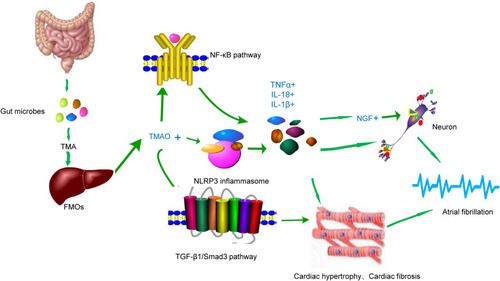Figures & data
Figure 1 The metabolic pathway of TMAO and its adverse effects on the body. Created by ScienceSlides Software and Microsoft Office PowerPoint Software. High-cholinergic foods are metabolized by intestinal microbes to form TMA, most of which enter the portal system through the blood circulation and are transferred into TMAO by the FMOs in the liver. Elevated TMAO has adverse impacts on various diseases.

Table 1 Clinical Investigations into TMAO and AF
Table 2 Main Pathophysiological Mechanisms of TMAO in AF: Directly and Indirectly
Table 3 Knowledge Gaps and Studies Needed to Be Performed
Figure 2 The underlying mechanism of AF caused by TMAO. Created by ScienceSlides Software and Microsoft Office PowerPoint Software. Elevated plasma TMAO levels can promote AF in different ways. Firstly, activating NLRP3 inflammatory bodies and the NF-κ B pathway leads to the release of inflammatory factors and further promotes NGF expression. Both inflammatory factors and NGF can stimulate atrial plexus and induce AF. On the other hand, TMAO can activate the TGF-β1/Smad3 signaling pathway, and the activated inflammatory factors further promote myocardial fibrosis and induce arrhythmia.

